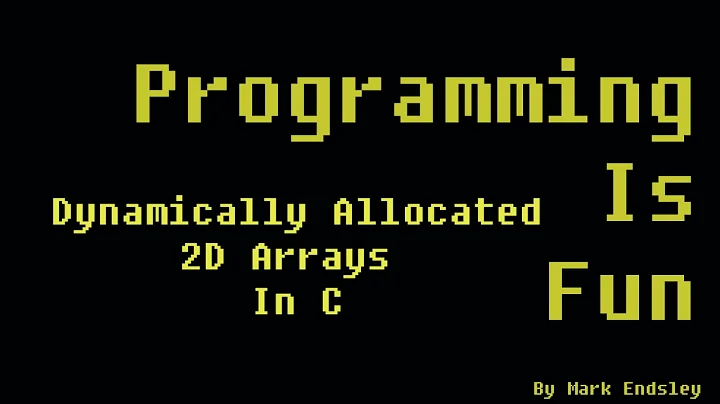How do you dynamically allocate a matrix?
Solution 1
A matrix is actually can be represented as an array of arrays.
int rows = ..., cols = ...;
int** matrix = new int*[rows];
for (int i = 0; i < rows; ++i)
matrix[i] = new int[cols];
Of course, to delete the matrix, you should do the following:
for (int i = 0; i < rows; ++i)
delete [] matrix[i];
delete [] matrix;
I have just figured out another possibility:
int rows = ..., cols = ...;
int** matrix = new int*[rows];
if (rows)
{
matrix[0] = new int[rows * cols];
for (int i = 1; i < rows; ++i)
matrix[i] = matrix[0] + i * cols;
}
Freeing this array is easier:
if (rows) delete [] matrix[0];
delete [] matrix;
This solution has the advantage of allocating a single big block of memory for all the elements, instead of several little chunks. The first solution I posted is a better example of the arrays of arrays concept, though.
Solution 2
You can also use std::vectors for achieving this:
using: 'std::vector< std::vector >'
Example:
#include <vector>
std::vector< std::vector<int> > a;
//m * n is the size of the matrix
int m = 2, n = 4;
//Grow rows by m
a.resize(m);
for(int i = 0 ; i < m ; ++i)
{
//Grow Columns by n
a[i].resize(n);
}
//Now you have matrix m*n with default values
//you can use the Matrix, now
a[1][0]=1;
a[1][1]=2;
a[1][2]=3;
a[1][3]=4;
//OR
for(i = 0 ; i < m ; ++i)
{
for(int j = 0 ; j < n ; ++j)
{ //modify matrix
int x = a[i][j];
}
}
Solution 3
#include <boost/multi_array.hpp>
int main(){
int rows;
int cols;
boost::multi_array<int, 2> arr(boost::extents[rows][cols] ;
}
Solution 4
arr = new int[cols*rows];
If you either don't mind syntax
arr[row * cols + col] = Aij;
or use operator[] overaloading somewhere. This may be more cache-friendly than array of arrays, or may be not, more probably you shouldn't care about it. I just want to point out that a) array of arrays is not only solution, b) some operations are more easier to implement if matrix located in one block of memory. E.g.
for(int i=0;i < rows*cols;++i)
matrix[i]=someOtherMatrix[i];
one line shorter than
for(int r=0;i < rows;++r)
for(int c=0;i < cols;++s)
matrix[r][c]=someOtherMatrix[r][c];
though adding rows to such matrix is more painful
Solution 5
const int nRows = 20;
const int nCols = 10;
int (*name)[nCols] = new int[nRows][nCols];
std::memset(name, 0, sizeof(int) * nRows * nCols); //row major contiguous memory
name[0][0] = 1; //first element
name[nRows-1][nCols-1] = 1; //last element
delete[] name;
Related videos on Youtube
chustar
I just hit 1500 reputation! - Wait, no I didn't... - Haha, yes I did!
Updated on July 09, 2022Comments
-
chustar almost 2 years
How do you dynamically allocate a 2D matrix in C++? I have tried based on what I already know:
#include <iostream> int main(){ int rows; int cols; int * arr; arr = new int[rows][cols]; }It works for one parameter, but now for two. What should I do?
-
dmckee --- ex-moderator kitten over 14 yearsBeen done over and over again: stackoverflow.com/questions/365782/… stackoverflow.com/questions/527887/… and others
-
pyon over 4 yearsIn retrospect, some of the other answers are simply much better than mine. (I still don't know C++, but at least now I'm aware that I don't know C++.) Would it be possible to accept one of them now?
-
-
pyon over 14 years+1 for using std::vector. I don't use the STL too much myself, but that's because I'm a masochist when it comes to memory management. Using the STL is way less error prone.
-
visual_learner over 14 yearsWhy would you try to hack up a two-dimensional array when it's perfectly easy to make a real two-dimensional array?
-
pyon over 14 years+1 for using Boost, but using such a library depends on how good the compiler you use is at optimizing your code.
-
 Asongfac Roland over 14 yearsbecause you can access the two-dimensional way in a cache friendly manner when performance is really key
Asongfac Roland over 14 yearsbecause you can access the two-dimensional way in a cache friendly manner when performance is really key -
pyon over 14 yearsEven better: allocate a 1D array of elements and another 1D array of pointers to the first element of every row.
-
dmckee --- ex-moderator kitten over 14 yearsWhile this works, it has a repeated manual overhead. You a prepared class (there are many) or wrap up c-style n-dimensional arrays in a class of your own devising.
-
greyfade over 14 yearsThat's not a bad idea. It has the obvious advantage of maintaining cache locality while still keeping the multidimensional array syntax. I like it.
-
 Rini Ann over 14 yearsInstead of resizing just construct it with the correct size.
Rini Ann over 14 yearsInstead of resizing just construct it with the correct size.int m = 10, n = 4; std::vector< std::vector<int> > a(m, std::vector<int>(n,0)); -
Patrizio Bertoni about 8 yearsI'd prefer the first, for the sake of clarity.
-
pyon about 8 years@PatrizioBertoni: I prefer the second, obviously. There's a cute trick for storing an arbitrary n-dimensional matrix
Mas two 1-dimensional arrays,c(coefficients) andx(actual elements). Then, given a vector of indicesi, thei-th element ofMis just thec*i-th element ofx, where*means dot product. I'm fond of this trick because (0) it works for arbitraryn, (1) it illustrates the importance of 0-based indexing, (2) for those of us who care about linear algebra, it demystifies tensor products... :-p -
 Andreas almost 7 yearsSome explanation would be just perfect! ;)
Andreas almost 7 yearsSome explanation would be just perfect! ;) -
CutePoison over 4 yearsWhy do we need to deallocate each row first? Why cant we just
delete [] matrix? -
pyon over 4 yearsIn the first possibility, each row has been allocated as a separate memory block.
-
 rcgldr almost 4 years@Andreas -
rcgldr almost 4 years@Andreas -nameis a pointer to an array of size nCols, in this case, a pointer to the first row of a matrix.name+iwould be a pointer to row[i] of the matrix. -
 Andreas almost 4 years@rcgldr Thank you but I perfectly understand the code. If someone adds an additional answer many years later when there are already lots of answers, even an accepted one, then it would be of great value if the answer gives a quick explanation about how it is different to the existing ones.
Andreas almost 4 years@rcgldr Thank you but I perfectly understand the code. If someone adds an additional answer many years later when there are already lots of answers, even an accepted one, then it would be of great value if the answer gives a quick explanation about how it is different to the existing ones. -
 rcgldr almost 4 years@Andreas - I lost an edit to my last comment. This method only works if the number columns is fixed. Otherwise an array of pointers seems like the best way to go. Doing a single allocation for the entire matrix, and a single allocation for the array of pointers only requires two allocations. If there is a maximum for the number of rows, then the array of pointers can be a fixed size array within a matrix class, only needing a single allocation for the data.
rcgldr almost 4 years@Andreas - I lost an edit to my last comment. This method only works if the number columns is fixed. Otherwise an array of pointers seems like the best way to go. Doing a single allocation for the entire matrix, and a single allocation for the array of pointers only requires two allocations. If there is a maximum for the number of rows, then the array of pointers can be a fixed size array within a matrix class, only needing a single allocation for the data. -
 rcgldr almost 4 years@Andreas - I wrote a matrix class that allows embedded matrices. The embedded matrix constructor has an additional parameter, a pointer to some row within another matrix, which it uses to initialize an array of pointers for the embedded matrix.
rcgldr almost 4 years@Andreas - I wrote a matrix class that allows embedded matrices. The embedded matrix constructor has an additional parameter, a pointer to some row within another matrix, which it uses to initialize an array of pointers for the embedded matrix. -
LCsa over 2 yearsWhy is the
if (rows)necessary before allocation/deletion? -
LCsa over 2 years@pyon Could you elaborate on the (2) tensor product part in your zero-indexed list? :D
-
pyon over 2 years@LCsa: Let $A$ be a commutative ring, let $M, N$ be $A$-modules, and let $S \subset M$ and $T \subset N$ be generating sets for them. Then $U = \{ m \otimes n : m \in M, n \in N \}$ is a generating set for the tensor product $M \otimes N$. Moreover, if $M, N$ are free $A$-modules and $S, T$ are $A$-bases of $M, N$, respectively, then $M \otimes N$ is also a free $A$-module and $U$ is a basis. Explicitly representing facts like this in a computer (whenever it is possible) makes it easier for me to get an intuitive feel for why they are true.







